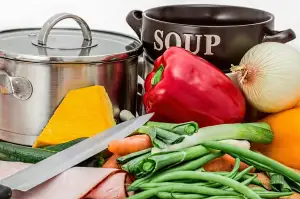Master the Art of Boiling Chicken: A Step-by-Step Guide to Perfectly Cooked Poultry

- Benefits of Boiling Chicken
- Step-by-Step Guide on How to Boil Chicken
- Choose the Right Chicken
- Prepare the Chicken
- Boiling the Chicken
- Checking for Doneness
- Shredding or Slicing the Boiled Chicken
- Tips and Variations for Boiling Chicken
- Adding Flavor to the Boiling Water
- Using Boiled Chicken in Recipes
- Storing Boiled Chicken
Boiling chicken is a simple and versatile cooking method that yields tender and juicy meat. Whether you're making chicken soup, salads, or sandwiches, mastering the art of boiling chicken is essential for any home cook. In this guide, we will take you through the step-by-step process of boiling chicken to perfection. From choosing the right chicken to shredding or slicing the cooked meat, get ready to elevate your culinary skills with this classic cooking technique.
Benefits of Boiling Chicken
Boiling chicken offers several advantages that make it a popular cooking method. Firstly, boiling helps to retain the natural flavors and juices of the chicken, resulting in tender and moist meat. Secondly, it is a healthier option as boiling allows the fat to melt away from the chicken, making it a low-fat cooking method. Additionally, boiling chicken also helps to create a flavorful broth that can be used in soups or sauces. Lastly, boiling is a simple and fuss-free way to cook chicken, making it perfect for beginners or those with limited time.
Step-by-Step Guide on How to Boil Chicken
1. Choose the Right Chicken: Select fresh chicken pieces or a whole chicken, depending on your preference. Ensure that the chicken is of good quality and free from any visible defects.
2. Prepare the Chicken: Rinse the chicken under cold water to remove any impurities. Pat it dry with paper towels. If desired, season the chicken with salt, pepper, or other spices for added flavor.
3. Boiling the Chicken: Place the chicken in a large pot and add enough water to cover it completely. You can also add aromatics like onions, garlic, or herbs to enhance the taste. Bring the water to a boil over medium-high heat.
4. Checking for Doneness: Reduce the heat to low and let the chicken simmer gently for about 20-30 minutes or until cooked through. To check if it's done, insert a meat thermometer into the thickest part of the meat – it should read 165°F (74°C). Alternatively, cut into the thickest piece to ensure there are no pink areas.
5. Shredding or Slicing the Boiled Chicken: Once cooked, remove the chicken from the pot using tongs or a slotted spoon and transfer it to a cutting board. Let it cool slightly before shredding or slicing it according to your recipe's requirements.
By following these simple steps, you can master the art of boiling chicken and achieve perfectly cooked poultry every time!
Choose the Right Chicken
When it comes to boiling chicken, choosing the right chicken is crucial for achieving the best results. Opt for fresh, high-quality chicken that is free from any signs of spoilage or discoloration. You can choose a whole chicken or specific cuts like bone-in breasts, thighs, or drumsticks. Consider your preference and the recipe you plan to use the boiled chicken in. Remember to remove any excess fat or skin before boiling for a healthier option.
Prepare the Chicken
To prepare the chicken for boiling, start by rinsing it under cold water to remove any excess blood or impurities. Pat it dry with paper towels. Next, remove any giblets or organs from the cavity of the chicken. Trim off any excess fat or skin if desired. Season the chicken with salt and pepper or your preferred spices for added flavor. Make sure to wash your hands and clean all surfaces thoroughly after handling raw chicken to prevent cross-contamination.
Boiling the Chicken
Once you have prepared the chicken, it's time to start boiling. Here's how to do it:
1. Fill a large pot with enough water to fully submerge the chicken. You can also add some aromatics like onion, garlic, and herbs for added flavor.
2. Place the pot on the stove over medium-high heat and bring the water to a boil.
3. Once the water is boiling, carefully add the chicken to the pot. Make sure it is fully submerged in the water.
4. Reduce the heat to low and let the chicken simmer gently. Cover the pot with a lid to retain heat and prevent evaporation.
5. The cooking time will vary depending on the size of your chicken pieces. Generally, boneless chicken breasts will take around 15-20 minutes, while bone-in pieces may take up to 30-40 minutes.
Remember to periodically skim off any foam or impurities that rise to the surface during boiling.
Boiling is a simple and foolproof method that ensures tender and juicy chicken every time.
Checking for Doneness
To ensure that your boiled chicken is perfectly cooked, it's important to check for doneness. One way to do this is by using a meat thermometer. Insert the thermometer into the thickest part of the chicken, making sure not to touch any bone. The internal temperature should reach 165°F (74°C) for the chicken to be considered safe to eat. If you don't have a thermometer, you can also check for doneness by cutting into the thickest part of the chicken and ensuring that there are no pink or raw areas. Once your chicken has reached the appropriate temperature and is fully cooked, it's ready to be shredded or sliced and used in your favorite recipes.
Shredding or Slicing the Boiled Chicken
Once the chicken is fully cooked and tender, it's time to shred or slice it. To shred the chicken, use two forks and pull the meat apart in opposite directions. This will create thin strands of chicken that are perfect for adding to salads, sandwiches, or tacos. If you prefer sliced chicken, allow it to cool slightly before using a sharp knife to cut it into thin slices. The choice between shredding or slicing depends on how you plan to use the chicken in your recipes.
Tips and Variations for Boiling Chicken
1. Adding Flavor to the Boiling Water: Enhance the taste of your boiled chicken by adding herbs, spices, or aromatics to the water. Try adding bay leaves, garlic cloves, peppercorns, or onions for a flavorful broth.
2. Using Boiled Chicken in Recipes: Once your chicken is perfectly boiled, you can use it in various recipes. Shred it and add it to salads, sandwiches, or wraps for a protein-packed meal. You can also dice it and use it in soups, stir-fries, or casseroles.
3. Storing Boiled Chicken: If you have leftover boiled chicken, store it properly to maintain its freshness. Allow it to cool completely before placing it in an airtight container or ziplock bag. Refrigerate for up to 3 days or freeze for longer storage.
These tips and variations will help you make the most out of your boiled chicken and add versatility to your culinary creations!
Adding Flavor to the Boiling Water
To enhance the taste of your boiled chicken, consider adding flavor to the boiling water. This simple step can take your dish from ordinary to extraordinary. Here are a few ways to infuse delicious flavors into the chicken as it cooks:
1. Herbs and Spices: Add a handful of fresh herbs like thyme, rosemary, or bay leaves to the boiling water. These aromatic herbs will impart a subtle yet delightful flavor to the chicken.
2. Aromatics: Enhance the taste by adding aromatics like onions, garlic, celery, or carrots to the boiling water. These ingredients will infuse their flavors into the chicken, resulting in a more flavorful end product.
3. Seasonings: Sprinkle some salt, pepper, or your favorite seasoning blend into the boiling water for an extra kick of flavor. Be mindful of not overdoing it; start with a small amount and adjust according to your taste preferences.
Remember that the flavors will penetrate the chicken during cooking, so don't be afraid to experiment with different combinations of herbs and spices. Adding flavor to the boiling water is an easy way to elevate your boiled chicken and make it even more enjoyable for your taste buds.
Using Boiled Chicken in Recipes
One of the great things about boiling chicken is that it can be used in a variety of recipes. The tender and flavorful meat can be added to salads, sandwiches, soups, and casseroles. It can also be used as a filling for tacos, enchiladas, or wraps. The possibilities are endless!
To incorporate boiled chicken into your recipes, simply shred or slice the cooked chicken according to your preference. For salads and sandwiches, you can mix it with mayonnaise or Greek yogurt and add some herbs or spices for extra flavor. In soups and casseroles, the boiled chicken can be added directly to the dish during cooking.
The mild taste of boiled chicken makes it versatile enough to pair well with different seasonings and ingredients. You can experiment with various herbs, spices, sauces, or marinades to create unique flavors that suit your taste buds.
Whether you're making a comforting chicken noodle soup or a zesty buffalo chicken salad, using boiled chicken will save you time without compromising on taste. So go ahead and get creative in the kitchen with this versatile ingredient!
Storing Boiled Chicken
Once you have boiled your chicken to perfection, it's important to store it properly to maintain its freshness and flavor. Here are some tips for storing boiled chicken:
1. Refrigeration: Allow the boiled chicken to cool completely before storing it in an airtight container or resealable bag. Place it in the refrigerator and consume within 3-4 days.
2. Freezing: If you want to store boiled chicken for a longer period, freezing is a great option. Divide the chicken into portions and place them in freezer-safe containers or bags. Label them with the date and use within 2-3 months.
3. Thawing: When you're ready to use the frozen boiled chicken, thaw it overnight in the refrigerator or use the defrost setting on your microwave. Avoid thawing at room temperature as it can lead to bacterial growth.
Remember, always practice proper food safety measures when handling and storing boiled chicken to ensure its quality and prevent any foodborne illnesses.
In conclusion, mastering the art of boiling chicken is a valuable skill that every home cook should have. Not only is it a simple and convenient cooking method, but it also yields tender and juicy meat that can be used in a variety of dishes. By following the step-by-step guide provided, you can ensure perfectly cooked poultry every time. Remember to choose the right chicken, properly prepare it, and check for doneness before shredding or slicing. Don't forget to experiment with adding flavors to the boiling water and explore different recipes that incorporate boiled chicken. Lastly, make sure to store any leftover boiled chicken properly for future use. So go ahead and start boiling your way to delicious meals!
Published: 20. 11. 2023
Category: Food



